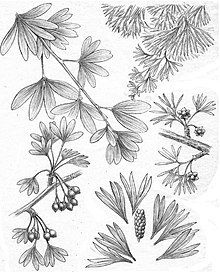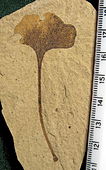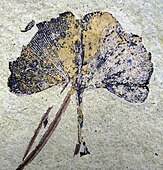Ginkgoales
| Ginkgoales Temporal range:
| |
|---|---|

| |
| Leaves and seeds of Ginkgo yimaensis (left) Yimaia recurva (top right) and Karkenia henanensis (bottom right) | |
| Scientific classification | |
| Kingdom: | Plantae |
| Clade: | Tracheophytes |
| Clade: | Gymnospermae |
| Division: | Ginkgophyta |
| Class: | Ginkgoopsida |
| Order: | Ginkgoales Gorozhankin, 1904 |
| Families | |
| |
Ginkgoales are a
Early Permian
around 300 million years ago from fossils found worldwide.
Evolution
Ginkgophyta and
Karkenia, which have differently arranged reproductive structures and seeds associated with Ginkgo-like leaves.[3][4] The diversity of Ginkgoales declined during the Late Cretaceous and Cenozoic, coincident with the rise of flowering plants, with all Ginkgophytes aside from Ginkgo being extinct by the end of the Cretaceous.[5][4] The only remaining Ginkgophyte was Ginkgo adiantoides – a polymorphic species.[6] Modern Ginkgo trees are native to China.[5]
Reproduction
Ginkgo trees produce ovulate and pollen-bearing structures. These structures are
ovules, about 2–3 cm in diameter, fall from the tree in the fall, and fertilization continues into the winter/spring.[4][6] This ovule contains a single large seed, similar to that of a cycad.[4]
Morphology
Ginkgophyte wood
Fossils that appear Ginkgo-like are filed under a
morphogenus called Ginkgoxylon, Ginkgomyeloxylon, or Protoginkgoxylon. Fossilized ginkgophyte wood is not commonly found in the record, possibly because it degrades easily, and possibly because it is difficult to tell apart from the much more pervasive conifer samples.[4] Like conifer wood, it has secondary thin-walled xylem and a primary vascular system composed of eustele and bifacial vascular cambium. The tracheids in the secondary xylem rays have pitting that occurs only on the walls and is circularly bordered.[5]

Ginkgophyte foliage
Ginkgophyte
stomata and isotopic profile give it a key role in recreations of the Mesozoic and Cenozoic. Leaf fossils that resemble the Ginkgophytes are known as Ginkgoites. There are similar, now extinct, morphogens, such as Sphenobaiera, which describes fan-shaped, deeply divided leaves without clear petioles
.
The distinctive shape of the modern Ginkgo biloba gives the impression of a very narrow leaf morphology, but the group is varied and diverse. The genus Ginkgo by itself contains a range of morphologies. Ginkgo digitata, from the
laminae with the intercostal regions covered in stomata and resin bodies, while G. pluripartita has at most 2 cm-long leaves and is intercostally hypostomatic.[4]
Fossil gallery
-
A 6.7 cm tall Ginkgo biloba leaf, with insect herbivory. Klondike Mountain Formation, Republic, Ferry County, Washington, USA, Eocene, Ypresian, 49 million years old
-
A 70 mm-wide Ginkgo biloba leaf. Klondike Mountain Formation, Republic, Ferry County, Washington, USA, Eocene, Ypresian, 49 million years old
-
Ginkgo biloba Eocene fossil leaf from the Tranquille Shale of MacAbee, British Columbia, Canada
-
Fossil of Ginkgo huttoni. Photo taken at Naturalis Museum in Leiden, The Netherlands.
-
Fossil of Ginkgoites huttoni
References
- ^ Christenhusz, M. J. M., J. L. Reveal, A. Farjon, M. F. Gardner, R. R. Mill, and M. W. Chase (2011). A new classification and linear sequence of extant gymnosperms. Phytotaxa 19:55–70. http://www.mapress.com/phytotaxa/content/2011/f/pt00019p070.pdf
- S2CID 236141481.
- .
- ^ ISBN 9780123739728.
- ^ a b c d Beck, Charles (2014). "Ginkgoales". Access Science. Retrieved April 13, 2017.
- ^ a b Jalalpour, Julie; Malkin, Matt; Poon, Peter; Rehrmann, Liz; Yu, Jerry (1997). "Introduction to the Ginkgoales". www.ucmp.berkeley.edu. Retrieved 2017-04-20.





